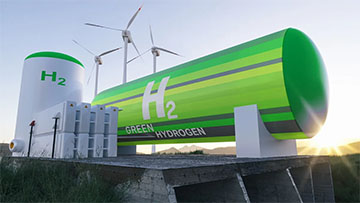Engineers use sound waves to increase green hydrogen production 14 times.
Sound waves make it much easier to extract hydrogen from water.
 Scientists from the University of RMIT in Australia have developed an innovative one, a promising way to increase the production of green hydrogen by a factor of 14 – by using sound waves through electrolysis to split water.
Scientists from the University of RMIT in Australia have developed an innovative one, a promising way to increase the production of green hydrogen by a factor of 14 – by using sound waves through electrolysis to split water.
According to the engineers, their invention could significantly reduce the cost of producing green hydrogen.
“One of the main challenges of electrolysis is the high cost of the electrode materials used, such as platinum or iridium," RMIT Associate Professor Amgad Rezk said in a statement, who directed the work.
"Thanks to the sound waves, which greatly facilitate the extraction of hydrogen from water, this eliminates the need for corrosive electrolytes and expensive electrodes, such as platinum and iridium. Because water is not a corrosive electrolyte, we can use much cheaper electrode materials, such as silver, Rez explained.
The research was published in Advanced Energy Material, and an Australian provisional patent application was filed to protect the new technology, according to release.
How electrolysis is used to produce green hydrogen?
Electricity flows through the water using two electrodes, which separates water molecules into oxygen and hydrogen. This process produces green hydrogen, which, due to its high energy demand, is only a "small fraction" of global hydrogen production.
So how is most of the hydrogen produced? By splitting natural gas, also known as blue hydrogen. Natural gas emits greenhouse gases into the atmosphere.
In their experiment, RMIT engineers used high-frequency vibrations to 'divide and conquer' individual water molecules during electrolysis.
“The electrical yield of electrolysis with sound waves was approx 14 times greater than electrolysis without them, at a given input voltage. This corresponded to the amount of hydrogen produced,” said first author Yemima Ehrnst.
The breakthrough is a huge step towards the use of a "new acoustic platform"
Ernst added, that the sound waves "also prevented the accumulation of hydrogen and oxygen bubbles on the electrodes, which greatly improved their conductivity and stability”.
“Electrode materials used in electrolysis are subject to the accumulation of hydrogen and oxygen, forming a layer of gas, which minimizes the activity of the electrodes and significantly reduces their efficiency,” said Dr. Ehrnst. scientist at the RMIT School of Engineering.
Professor Leslie Yeo, one of the leading scientists, he said, that the breakthrough was a huge step towards using the "new acoustic platform" for other applications.
“Our ability to suppress bubble build-up on the electrodes and remove them quickly through high-frequency vibration represents a major advance in the conductivity and stability of electrodes. With our method, we can potentially improve conversion performance, leading to a positive net energy saving of o 27 percent", said Yeo of the RMIT School of Engineering.
However, integrating sonic wave innovations into current electrolyzers to scale up operations is challenging, on which the team must work.
Abstract of the study:
A novel strategy using hybrid high-frequency sound waves is presented (10 MHz) to dramatically enhance the hydrogen evolution reaction (HER) in notoriously difficult neutral electrolytes by modifying their grid coordination state. Practical constraints associated with existing electrolyser technology are considered here, including the need for highly corrosive electrolytes and expensive electrocatalysts, by redefining conceptually poor hydrogen electrocatalysts in neutral electrolytes. The improvement in HER performance is attributed to the unique ability of intense local electromechanical coupling resulting from acoustic excitation to "frustrate" the tetrahedral coordinated hydrogen bonding network of water molecules at the electrode-electrolyte interface, which results in the generation of a high concentration of "free" water molecules, which have easier access to the catalytic sites on the unmodified polycrystalline electrode. Along with other synergistic effects, that accompany the acoustic excitation (np. generation of hydronium ions, convective relaxation of diffusion mass transfer constraints and prevention of bubble build-up and removal from the electrode), the resulting overpotential reduction o 1,4 V at – 100 mA cm-2 and a corresponding 14-fold increase in current density, together with a positive net energy saving of 27,3%, shows the potential of this technology as a scalable platform for effectively increasing the efficiency of green hydrogen production.









